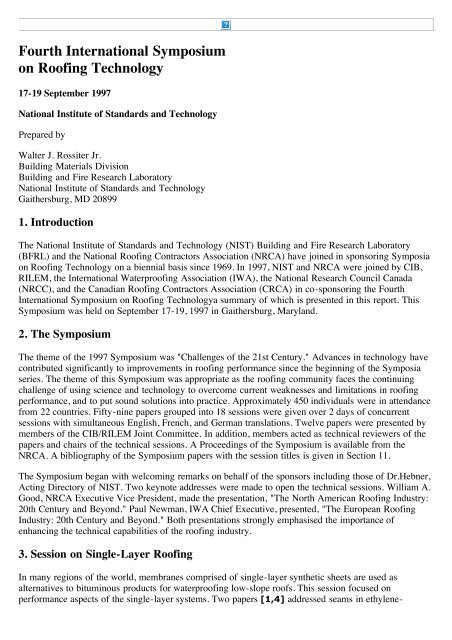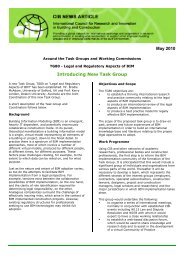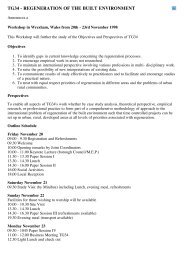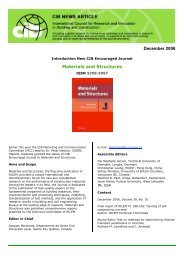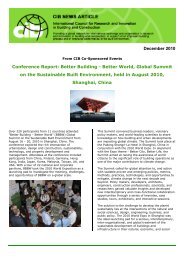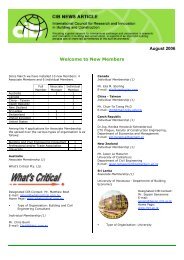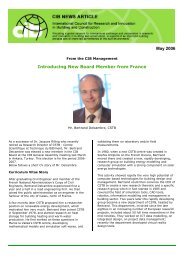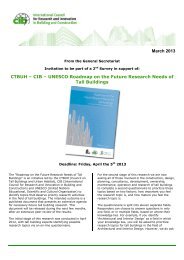Fourth International Symposium on Roofing Technology - CIB
Fourth International Symposium on Roofing Technology - CIB
Fourth International Symposium on Roofing Technology - CIB
You also want an ePaper? Increase the reach of your titles
YUMPU automatically turns print PDFs into web optimized ePapers that Google loves.
<str<strong>on</strong>g>Fourth</str<strong>on</strong>g> <str<strong>on</strong>g>Internati<strong>on</strong>al</str<strong>on</strong>g> <str<strong>on</strong>g>Symposium</str<strong>on</strong>g><br />
<strong>on</strong> <strong>Roofing</strong> <strong>Technology</strong><br />
17-19 September 1997<br />
Nati<strong>on</strong>al Institute of Standards and <strong>Technology</strong><br />
Prepared by<br />
Walter J. Rossiter Jr.<br />
Building Materials Divisi<strong>on</strong><br />
Building and Fire Research Laboratory<br />
Nati<strong>on</strong>al Institute of Standards and <strong>Technology</strong><br />
Gaithersburg, MD 20899<br />
1. Introducti<strong>on</strong><br />
The Nati<strong>on</strong>al Institute of Standards and <strong>Technology</strong> (NIST) Building and Fire Research Laboratory<br />
(BFRL) and the Nati<strong>on</strong>al <strong>Roofing</strong> C<strong>on</strong>tractors Associati<strong>on</strong> (NRCA) have joined in sp<strong>on</strong>soring Symposia<br />
<strong>on</strong> <strong>Roofing</strong> <strong>Technology</strong> <strong>on</strong> a biennial basis since 1969. In 1997, NIST and NRCA were joined by <strong>CIB</strong>,<br />
RILEM, the <str<strong>on</strong>g>Internati<strong>on</strong>al</str<strong>on</strong>g> Waterproofing Associati<strong>on</strong> (IWA), the Nati<strong>on</strong>al Research Council Canada<br />
(NRCC), and the Canadian <strong>Roofing</strong> C<strong>on</strong>tractors Associati<strong>on</strong> (CRCA) in co-sp<strong>on</strong>soring the <str<strong>on</strong>g>Fourth</str<strong>on</strong>g><br />
<str<strong>on</strong>g>Internati<strong>on</strong>al</str<strong>on</strong>g> <str<strong>on</strong>g>Symposium</str<strong>on</strong>g> <strong>on</strong> <strong>Roofing</strong> <strong>Technology</strong>a summary of which is presented in this report. This<br />
<str<strong>on</strong>g>Symposium</str<strong>on</strong>g> was held <strong>on</strong> September 17-19, 1997 in Gaithersburg, Maryland.<br />
2. The <str<strong>on</strong>g>Symposium</str<strong>on</strong>g><br />
The theme of the 1997 <str<strong>on</strong>g>Symposium</str<strong>on</strong>g> was "Challenges of the 21st Century." Advances in technology have<br />
c<strong>on</strong>tributed significantly to improvements in roofing performance since the beginning of the Symposia<br />
series. The theme of this <str<strong>on</strong>g>Symposium</str<strong>on</strong>g> was appropriate as the roofing community faces the c<strong>on</strong>tinuing<br />
challenge of using science and technology to overcome current weaknesses and limitati<strong>on</strong>s in roofing<br />
performance, and to put sound soluti<strong>on</strong>s into practice. Approximately 450 individuals were in attendance<br />
from 22 countries. Fifty-nine papers grouped into 18 sessi<strong>on</strong>s were given over 2 days of c<strong>on</strong>current<br />
sessi<strong>on</strong>s with simultaneous English, French, and German translati<strong>on</strong>s. Twelve papers were presented by<br />
members of the <strong>CIB</strong>/RILEM Joint Committee. In additi<strong>on</strong>, members acted as technical reviewers of the<br />
papers and chairs of the technical sessi<strong>on</strong>s. A Proceedings of the <str<strong>on</strong>g>Symposium</str<strong>on</strong>g> is available from the<br />
NRCA. A bibliography of the <str<strong>on</strong>g>Symposium</str<strong>on</strong>g> papers with the sessi<strong>on</strong> titles is given in Secti<strong>on</strong> 11.<br />
The <str<strong>on</strong>g>Symposium</str<strong>on</strong>g> began with welcoming remarks <strong>on</strong> behalf of the sp<strong>on</strong>sors including those of Dr.Hebner,<br />
Acting Directory of NIST. Two keynote addresses were made to open the technical sessi<strong>on</strong>s. William A.<br />
Good, NRCA Executive Vice President, made the presentati<strong>on</strong>, "The North American <strong>Roofing</strong> Industry:<br />
20th Century and Bey<strong>on</strong>d." Paul Newman, IWA Chief Executive, presented, "The European <strong>Roofing</strong><br />
Industry: 20th Century and Bey<strong>on</strong>d." Both presentati<strong>on</strong>s str<strong>on</strong>gly emphasised the importance of<br />
enhancing the technical capabilities of the roofing industry.<br />
3. Sessi<strong>on</strong> <strong>on</strong> Single-Layer <strong>Roofing</strong><br />
In many regi<strong>on</strong>s of the world, membranes comprised of single-layer synthetic sheets are used as<br />
alternatives to bituminous products for waterproofing low-slope roofs. This sessi<strong>on</strong> focused <strong>on</strong><br />
performance aspects of the single-layer systems. Two papers [1,4] addressed seams in ethylene-
propylene-diene (EPDM) membranes. In recent years, adhesive tapes have begun to supplant c<strong>on</strong>tacttype<br />
liquid adhesives in forming seams in service. One paper [1] reported the results of a study<br />
comparing the creep-rupture resp<strong>on</strong>se (i.e., time-to-failure under load) of these two types of adhesive<br />
systems. A main c<strong>on</strong>clusi<strong>on</strong> was that the tape samples had mean times-to-failure that were, in most<br />
cases, comparable to, or greater than, those of the liquid-adhesive samples. The sec<strong>on</strong>d paper [4]<br />
described a testing protocol that may be used to evaluate any adhesive used for EPDM membranes.<br />
Comparative data were presented <strong>on</strong> tape samples and liquid-adhesive samples. In general, the tape<br />
samples had comparable, if not greater values, in the tests c<strong>on</strong>ducted.<br />
Thermoplastic polyolefin (TPO) membranes have been recently introduced into the roofing industry. One<br />
paper [2] discussed the importance of selecting proper flame retardants when formulating TPO sheet<br />
materials and also discussed a study <strong>on</strong> the envir<strong>on</strong>mental impact of the TPOs. In presenting background<br />
informati<strong>on</strong> for the paper, it was pointed out that bromine-c<strong>on</strong>taining compounds are comm<strong>on</strong>ly used as<br />
flame retardants. However, data presented indicated that membrane products with n<strong>on</strong>-brominated<br />
compounds have higher UV stability, and recommendati<strong>on</strong>s were made that formulati<strong>on</strong>s not use<br />
bromine compounds. The study investigating the envir<strong>on</strong>mental impact c<strong>on</strong>sidered all steps of a n<strong>on</strong>brominated<br />
TPO's life cycle, and showed the material to be envir<strong>on</strong>mentally friendly. This ecological<br />
study provided an example of the extensive efforts that might need to be undertaken in examining the<br />
envir<strong>on</strong>mental impact of a roofing membrane material.<br />
A fourth paper [3] in the sessi<strong>on</strong> addressed the performance of poly (vinyl chloride) (PVC) roofing. In<br />
the past, n<strong>on</strong>reinforced PVC membranes, which are not installed today, experienced performance<br />
problems associated with loss of plasticiser from the sheet. In evaluating existing roofs for signs of<br />
potential problems, visual examinati<strong>on</strong> has often been c<strong>on</strong>ducted without support of laboratory testing.<br />
The author presented data from a variety of test methods including thickness, tensile strength, el<strong>on</strong>gati<strong>on</strong>,<br />
plasticiser c<strong>on</strong>tent, specific gravity, and hardness. He offered that use of these methods enhances the<br />
evaluati<strong>on</strong> process and should complement visual examinati<strong>on</strong>.<br />
4. Sessi<strong>on</strong> <strong>on</strong> Asphalt Shingles<br />
Asphalt shingles comprise the most comm<strong>on</strong>ly used watershedding covering for pitched roofing in the<br />
United States. A major problem facing the industry is unsightly discolorati<strong>on</strong> due to algae growth <strong>on</strong> the<br />
shingle granules. In a recent development [12], steps have been taken to overcome the problem through<br />
the use of copper-c<strong>on</strong>taining granules <strong>on</strong> the shingles. These granules release cupric i<strong>on</strong>s in a c<strong>on</strong>trolled<br />
fashi<strong>on</strong> uniformly over the roof with time. A mathematical model of the c<strong>on</strong>trolled release correlates<br />
well to real-time exposure studies of copper-granule performance.<br />
Another presentati<strong>on</strong> was a paper <strong>on</strong> the applicati<strong>on</strong> of the performance c<strong>on</strong>cept to shingles [13]. The<br />
authors proposed a model, which they designated as the Assessment of Performance Tests (APT) model,<br />
for identifying perspective performance tests for shingles. They proposed five criteria that need to be<br />
satisfied by a performance test: logic, validity, material independence, repeatability and reproducibility,<br />
and cost-effectiveness. By way of example, the authors applied the APT model to three tests currently<br />
used to evaluate asphalt shingles. They c<strong>on</strong>cluded that n<strong>on</strong>e satisfied the five criteria totally. They<br />
recommended that the further development of tests for asphalt shingles be c<strong>on</strong>sistent with the APT<br />
model.<br />
5. Sessi<strong>on</strong> <strong>on</strong> Low-Slope Roof System Performance<br />
Statistical data <strong>on</strong> the service lives of low-slope roofing systems have not been readily available to the<br />
industry. A prime reas<strong>on</strong> is that, historically, mechanisms for tracking performance of systems that may<br />
be in service for 15 years or more have not been in place. Now, with the comm<strong>on</strong> use of computers for<br />
keeping data, data files <strong>on</strong> services lives of roof systems are beginning to appear. Three papers [15-17]<br />
gave examples of the use of databases for tracking and analysing service performancetechniques that will<br />
undoubtedly make an impact <strong>on</strong> the industry in the years ahead.
One paper [15] discussed the relative durability of membrane roofing systems based <strong>on</strong> a 1996 nati<strong>on</strong>wide<br />
survey that the author c<strong>on</strong>ducted of the U.S. roofing industry. Using data from the survey, the mean<br />
and minimum service lives, and durability ranges for comm<strong>on</strong> roofing membranes were calculated. The<br />
data were further analysed, based <strong>on</strong> the Arrhenius c<strong>on</strong>cept, to determine the effect of thermal exposure<br />
<strong>on</strong> durability. It was found that mean durability decreased significantly for some systems with increase in<br />
temperature; whereas the service lives of other systems did not appear to be affected.<br />
A sec<strong>on</strong>d paper [16] presented data from the roofing warranty database of a major manufacturer. The<br />
database covered more than 2 108 m2 of EPDM and polymer-modified bitumen roofing installed<br />
between 1982 and the present. Because the data were from warranty files, roof repair costs over time<br />
were known. Roof performance was defined as the repair expense per unit of membrane surface area for<br />
a specified period of time. Using this definiti<strong>on</strong>, comparative performance of the two types of roofing<br />
was discussed. Examples of improvements in performance based <strong>on</strong> changes in technology such as the<br />
use of EPDM seams tapes in lieu of liquid-adhesives (see Secti<strong>on</strong> 3) were noted.<br />
The final paper [17] reported <strong>on</strong> a database that has been under development by the authors since 1975.<br />
To date, the database c<strong>on</strong>tains about 24000 files <strong>on</strong> low-sloped roofing systems and shingle roofing. All<br />
files in the database include informati<strong>on</strong> <strong>on</strong> actual lifetime; that is, it is known when the roof in questi<strong>on</strong><br />
was replaced. The authors presented examples of the informati<strong>on</strong> that may be obtained from the<br />
database. Comparative service lives of the different types of low-sloped roofing systems were noted. In<br />
additi<strong>on</strong>, initial costs versus life cycle costs for these systems were compared. The authors intend to<br />
expand and refine the database in the years ahead.<br />
6. Sessi<strong>on</strong> <strong>on</strong> Wind Engineering<br />
The performance of roofing systems subjected to high wind events has been topical in the roofing<br />
industry in recent yearspartially motivated by destructive storms such as Hurricane Hugo and Hurricane<br />
Andrew that caused extensive roofing damage. Moreover, test methods historically used by the roofing<br />
industry for evaluating the wind uplift resistance of bituminous membrane systems are not applicable to<br />
many of the newer systems such as mechanically attached synthetic membranes. C<strong>on</strong>sequently, new<br />
methods for uplift resistance are being sought. Three papers [21-23] in this sessi<strong>on</strong> addressed the uplift<br />
resistance issue.<br />
The static uplift resistance of EPDM and TPO mechanically-fastened synthetic membrane systems was<br />
the subject of <strong>on</strong>e paper [21]. Tests were performed using various sized chambers to determine whether<br />
a minimum size could be identified. Uplift loads <strong>on</strong> fasteners were measured during the testing, and<br />
compared with calculated loads based <strong>on</strong> the pressures to which the system was subjected during testing.<br />
It was c<strong>on</strong>cluded that a chamber with minimum dimensi<strong>on</strong>s of 2.4by 2.4would suffice to allow calculated<br />
fastener loads to reas<strong>on</strong>ably approximate the measured fastener load.<br />
The Nati<strong>on</strong>al Research Council of Canada has c<strong>on</strong>structed a facility for the dynamic uplift evaluati<strong>on</strong> of<br />
roofing systems. A paper [22] described the facility and presented initial data developed using three<br />
different loading protocols <strong>on</strong> a mechanically-fastened PVC system. Comparative performance of the<br />
system was discussed. Investigati<strong>on</strong>s are c<strong>on</strong>tinuing using other synthetic membrane systems.<br />
A paper [23] presented by the Asphalt <strong>Roofing</strong> Manufacturers Associati<strong>on</strong> (ARMA) summarised<br />
research in developing an improved test method for evaluating the uplift resistance of asphalt shingles.<br />
Wind tunnel studies were c<strong>on</strong>ducted to determine single uplift pressures. These results were validated<br />
from wind experiments <strong>on</strong> a single-story test house c<strong>on</strong>structed outdoors at a windy locati<strong>on</strong> in<br />
Colorado. Based <strong>on</strong> the tests, a model was developed for calculating the uplift pressure <strong>on</strong> a shingle for a<br />
specified wind c<strong>on</strong>diti<strong>on</strong>. Laboratory testing c<strong>on</strong>ducted <strong>on</strong> shingle specimens prepared to simulate in<br />
field applicati<strong>on</strong> practices can be c<strong>on</strong>ducted to determine whether the shingle has adequate resistance to<br />
withstand the predicted uplift pressure. At present, the necessary test method is under development by<br />
ASTM Technical Committee D<strong>on</strong> <strong>Roofing</strong>, Waterproofing and Bituminous Materials.
7. Sessi<strong>on</strong> <strong>on</strong> In-Service Performance<br />
Techni<strong>on</strong>, the Israel Institute of <strong>Technology</strong>, has been measuring the properties of membrane<br />
samplesPVC, EPDM, and polymer modified bitumenscollected from all parts of Israel [31]. The<br />
performance of the roofs, having ages ranging from 4 years to 12 years, were well documented. In<br />
general, it was found that the membranes maintained much of their original properties over the exposure<br />
periods.<br />
In the early 1980s, the U.S. Army Corps of Engineers initiated studies to evaluate new roofing systems<br />
for installati<strong>on</strong> <strong>on</strong> Army facilities as alternatives to the c<strong>on</strong>venti<strong>on</strong>al bituminous roofing systems<br />
comm<strong>on</strong>ly used at the time [33]. One system evaluated was PVC. In that study, experimental roofs<br />
having PVC membranes from three suppliers were installed at three Army facilities. For 10 years,<br />
samples were obtained periodically and subjected to laboratory testing. Also, annual visual inspecti<strong>on</strong>s of<br />
the roofs were c<strong>on</strong>ducted. It was found that most test results could not distinguish between the<br />
comparative performances observed at the different locati<strong>on</strong>s. Only in the case of thickness and tear<br />
strength measurements were significant property changes found for the better performing roofs. It was<br />
c<strong>on</strong>cluded that further work needs to be c<strong>on</strong>ducted to determine whether the two tests may be used as<br />
performance indicators for PVC membranes.<br />
For about 30 years, sprayed polyurethane foam (SPF) roof systems have been used in the United<br />
States. These roofs offer significant benefits for energy c<strong>on</strong>servati<strong>on</strong> due to the high thermal resistance<br />
of the polyurethane foam and lack of joints and mechanical fasteners. To further the understanding of the<br />
performance of these systems, a field study was undertaken [34]. One hundred and forty roofs were<br />
inspected from different climatic regi<strong>on</strong>s and samples were obtained for laboratory testing. The ages of<br />
the roofs ranged from 0.5 years to 27 years. In general, it was found that the measured properties of the<br />
samples were acceptable. Design guidelines were recommended for enhancing SPF performance<br />
including a need to provide better drainage.<br />
8. Sessi<strong>on</strong> <strong>on</strong> Moisture Detecti<strong>on</strong> and Insulati<strong>on</strong><br />
Moisture in low-slope roof systems can have detrimental c<strong>on</strong>sequences including accelerating the<br />
deteriorati<strong>on</strong> of material comp<strong>on</strong>ents and reducing the energy efficiency of the system. Roofs must be<br />
kept dry and, when moisture accumulates, its presence and source must be recognised early. When leaks<br />
are the source, the locati<strong>on</strong>s need to be identified so that repairs can be made. Two papers [47,49]<br />
discussed techniques for detecting moisture in low-slope roof systems. The first [47] reviewed a method<br />
known as the electrical earth leakage technique, which is in practice in the United Kingdom, but not in<br />
the U.S. Using the method, an electrical potential difference is set up between a wet roof surface and a<br />
grounded roof deck. If leaks are present, a small electric current flows across the roof surface and<br />
through the membrane leak to the grounded deck. Using two probes c<strong>on</strong>nected to an ammeter, the<br />
directi<strong>on</strong> of the current is identified; by moving the probes, the locati<strong>on</strong> of the leak is identified. The<br />
author provided rooftop examples of using this technique, and discussed its advantages and limitati<strong>on</strong>s.<br />
The sec<strong>on</strong>d paper [49] described two experimental techniques, designated the metallic time-domain<br />
reflector (MTDR) method and the passive res<strong>on</strong>ance roof moisture detector (PRMD) method, that have<br />
been developed for detecting the presence of moisture in a low-slope roof system. The MTDR method is<br />
based <strong>on</strong> generating an electromagnetic pulse that propagates al<strong>on</strong>g a sensing cable that is set within the<br />
membrane roof system and c<strong>on</strong>sists of two parallel c<strong>on</strong>ductors. A boundary between two media with<br />
different dielectric c<strong>on</strong>stants, such as dry and wet materials surrounding the cable, causes a porti<strong>on</strong> of<br />
the propagating pulse energy to be reflected back to the source. The remaining porti<strong>on</strong> c<strong>on</strong>tinues al<strong>on</strong>g<br />
the cable encountering other boundaries, if present, or reflecting at the end of the cable to the source.<br />
Knowing the nature of the dielectric media through which the pulse travels and the travel time allows<br />
calculati<strong>on</strong> of the distance from the source to each of the boundaries encountered. The PRMD method is<br />
based <strong>on</strong> incorporating individual sensors in the membrane roof system. These sensors are comprised of
two passive electr<strong>on</strong>ic comp<strong>on</strong>ents, a capacitor (C) and an inductor (L), assembled to form a parallel LC<br />
circuit. If the inductor is initially fully charged from an external electromagnetic source of energy and<br />
the capacitor is uncharged, the inductor will discharge inducing a potential to exist across the capacitor<br />
causing it to become charged. Once complete, the process reverses itself and is periodic, oscillating from<br />
<strong>on</strong>e energy storage state to the other at a res<strong>on</strong>ance frequency until "circuit" (e.g., heat) losses dissipate<br />
the energy. Sensors located in dry regi<strong>on</strong>s of the roof res<strong>on</strong>ate at a different frequency than those in wet<br />
regi<strong>on</strong>s. Accessory equipment is used for energising the circuit in the roof, and detecting the resulting<br />
oscillati<strong>on</strong>s. Both methods have been dem<strong>on</strong>strated to be feasible in the laboratory. The authors<br />
c<strong>on</strong>cluded that the MTDR method is ready for refinement using rooftop experiments, whereas the PRMD<br />
method needs further laboratory development.<br />
A third paper [48] addressed an issue associated with the deteriorati<strong>on</strong> of roof system materials in the<br />
presence of moisture; namely, the freeze-thaw cycling of insulati<strong>on</strong>s. In this study, insulati<strong>on</strong>s<br />
comm<strong>on</strong>ly used in low-slope roofing practice were subjected up to 948 cycles of freezing in air and<br />
thawing in water. The moisture c<strong>on</strong>tents, and the effect of the moisture <strong>on</strong> thermal resistance, were<br />
quantified. Most insulati<strong>on</strong>s became very wet, and lost much of their insulating ability; some were<br />
extensively damaged.<br />
9. Sessi<strong>on</strong> <strong>on</strong> Modelling of Moisture C<strong>on</strong>trol<br />
Recent studies have resulted in the emergence of analytical models for predicting the transfer of moisture<br />
in roof systems. Two papers [53,54] in this sessi<strong>on</strong> were based <strong>on</strong> roofing applicati<strong>on</strong>s of the model,<br />
MOIST, which had been primarily developed at NIST. MOIST predicts both heat and moisture transfer<br />
in building cavities such as roofs, attics, and cathedral ceilings. In the first paper [53], the model was<br />
used to simulate the performance of a roof of a double-wide manufactured house c<strong>on</strong>structed in<br />
accordance with the standards promulgated for manufactured-housing by the U.S. Department of<br />
Housing and Urban Development (HUD). Parametric studies examined practices that deviated from<br />
those recommended. Am<strong>on</strong>g the findings, the analysis showed that airflow from the house into the roof<br />
cavity, as opposed to water-vapour diffusi<strong>on</strong>, was the dominant moisture transfer mechanism into the<br />
roof cavity during the winter. The analysis predicted that the rate of mechanical roof cavity ventilati<strong>on</strong>,<br />
as specified in the HUD standards, is too small for removing moisture during the winter, and needs to be<br />
increased.<br />
In the sec<strong>on</strong>d paper [54], MOIST was applied to the analysis of 15 open attic and cathedral ceiling<br />
designs that the U.S. Department of Energy (DoE) had suggested as suitable for minimising moisture<br />
problems in such roof c<strong>on</strong>structi<strong>on</strong>s. The MOIST analysis focused <strong>on</strong> predicting the peak values of the<br />
moisture c<strong>on</strong>tent of the plywood roof sheathing and the relative humidity at the bottom of the insulati<strong>on</strong><br />
adjacent to the ceiling. Parametric studies investigated practices that differed from the DoE practices.<br />
Am<strong>on</strong>g the findings, the analyses showed that the moisture c<strong>on</strong>tents of the wood sheathing for the 15<br />
DoE suggested c<strong>on</strong>structi<strong>on</strong>s were within allowable limits. However, some of the parametric studies, for<br />
example, with closed attic vents, revealed cases where moisture accumulati<strong>on</strong> could be problematic.<br />
The third paper [55] reported the results of a Danish investigati<strong>on</strong> <strong>on</strong> the performance of unventilated<br />
tile roofing systems that have come into comm<strong>on</strong> practice in that country. In such systems, the use of<br />
underlayments to c<strong>on</strong>trol moisture transfer is important. The investigati<strong>on</strong> focused <strong>on</strong> the performance of<br />
the underlayments, and their effects <strong>on</strong> winter time moisture accumulati<strong>on</strong> in the roof system. Laboratory<br />
and full-scale field testing were complemented by computer simulati<strong>on</strong>s <strong>on</strong> moisture flow. These<br />
simulati<strong>on</strong>s were performed using a program named MATCH. From the results of the investigati<strong>on</strong>, a<br />
number of design guidelines for use of unventilated tile roofing systems in Denmark were drawn.<br />
10. Summary<br />
The <str<strong>on</strong>g>Symposium</str<strong>on</strong>g> was successful in a variety ways. The Proceedings provide a valuable reference<br />
document c<strong>on</strong>taining recommendati<strong>on</strong>s <strong>on</strong> improving roofing performance. Many papers addressed
problems and c<strong>on</strong>cerns that the roofing industry has faced in recent years. Soluti<strong>on</strong>s for correcting or<br />
alleviating such problems were proposed. Other papers reviewed l<strong>on</strong>gstanding industry practices with<br />
emphasis <strong>on</strong> using the less<strong>on</strong>s learned to promote satisfactory performance. The participants listened<br />
attentively to the papers, as dem<strong>on</strong>strated by the number and depth of the questi<strong>on</strong>s asked of the authors<br />
after their presentati<strong>on</strong>s. This is important, because the individuals in attendance are those who will put<br />
the speakers' recommendati<strong>on</strong>s into practice.<br />
The <str<strong>on</strong>g>Symposium</str<strong>on</strong>g> dem<strong>on</strong>strated that roofing technology c<strong>on</strong>tinues to advance for the betterment of the<br />
industryparticularly in the use of computers to further the understanding of roof performance. This was<br />
evidenced in a number of papers such as those describing the use of databases <strong>on</strong> roof service lives and<br />
mathematical analyses of system specific issues such as moisture migrati<strong>on</strong>. The hope is that these<br />
papers will serve as examples for many more such papers to come in future years.<br />
11. Bibliography of <str<strong>on</strong>g>Symposium</str<strong>on</strong>g> Papers<br />
Sessi<strong>on</strong> 1A -- Single-Layer <strong>Roofing</strong><br />
[1] Rossiter, W., Vangel, M., and Kraft, K., "Performance of Tape-B<strong>on</strong>ded Seams of EPDM<br />
Membranes: The Effect of Load <strong>on</strong> Peel-Creep."<br />
[2] Beer, H., "L<strong>on</strong>gevity and Ecology of Polyolefin Roof Membranes."<br />
[3] Ko<strong>on</strong>tz, J., "Field Evaluati<strong>on</strong> and Laboratory Testing of PVC Roof Systems."<br />
[4] Fieldhouse, J., Chmiel, C., Kalwara, J., and Kane, E., "Evaluati<strong>on</strong> and Qualificati<strong>on</strong> of Tape<br />
Adhesive for Splicing EPDM Membrane."<br />
Sessi<strong>on</strong> 1B -- Service Life Evaluati<strong>on</strong><br />
[5] Kirn, W., Grecian, D., Ketz, R., Powell, T., and Simm<strong>on</strong>s, J., "On Investigating the Mechanism of<br />
Weathering of Chlorosulf<strong>on</strong>ated Polyethylene <strong>Roofing</strong> and Exploring Maintenance Techniques."<br />
[6] Kyle, B. and Kalinger, P., "Service Life Predicti<strong>on</strong> of Roof Systems by Reliability-Based Analysis."<br />
[7] Paroli, R., Rossiter, W., Flüeler, P., and Delgado, A., "Using Thermoanalytical Techniques to<br />
Characterize Roof Membrane Materials."<br />
[8] Terrenzio, L., Harris<strong>on</strong> J., Nester, D., and Shiao, M., "Natural vs. Artificial Aging: Use of Diffusi<strong>on</strong><br />
Theory to Model Asphalt and Fiberglass-Reinforced Shingle Performance."<br />
Sessi<strong>on</strong> 2A -- <strong>Technology</strong> Review I<br />
[9] Booth, R., "Practical Experiences with Bituminous Low-Slope Roofs in Cold Climates."<br />
[10] Portfolio, D. and Dutt<strong>on</strong>, E., "The Future of Roof Coatings."<br />
[11] Litow, E., "Practical Experiences in Design, Applicati<strong>on</strong> and Field Performance."<br />
Sessi<strong>on</strong> 2B -- Asphalt Shingles<br />
[12] Jacobs, J. and Thakur, R., "How Advances in Algae-Resistant <strong>Roofing</strong> Address the Growing Roof<br />
Algae Problem."
[13] Phillips, A., Jeffries, R., Blanchard, W., Frankoski, S., and Hardy-Pierce H., "The APT Model for<br />
Assessment of Prospective Shingle Performance Test Methods."<br />
[14] Shaw, D., "The Use of Fly Ash in the Manufacture of Asphalt Shingles."<br />
Sessi<strong>on</strong> 3A -- Low-Slope Roof System Performance<br />
[15] Cash, C., "The Relative Durability of Low-Slope <strong>Roofing</strong>."<br />
[16] Hoff, J., "Historical Warranty Repair Cost as a Measure of L<strong>on</strong>g-Term Roof System<br />
Performance."<br />
[17] Schneider, K. and Keenan, A., "A Documented Historical Performance of <strong>Roofing</strong> Assemblies in<br />
the United States, 1975-1996."<br />
Sessi<strong>on</strong> 3B -- Metal <strong>Roofing</strong><br />
[18] El-Atrouzy, M., "Cylindrical Shell Roofs Made of Corrugated Metal Sheets."<br />
[19] Meyers, L., Koziol, R., Johns<strong>on</strong>, D., and Krogstad, N., "Laboratory Testing for Low-Slope<br />
Standing Seam Metal Roof Applicati<strong>on</strong>."<br />
[20] Buska, J., Tobiass<strong>on</strong>, W., Greatorex, A., and Fyall, W., "Electric Heating Systems for Combating<br />
Icing Problems <strong>on</strong> Metal Roofs."<br />
Sessi<strong>on</strong> 4A -- Wind Engineering<br />
[21] Prevatt, D., Schiff, S., and Malpezzi, J., "Investigati<strong>on</strong> of Chamber Size for Uplift Performance<br />
Testing of Single-Ply Roof Systems."<br />
[22] Baskaran, A. And Lei, W., "A New Facility for the Dynamic Wind Performance Evaluati<strong>on</strong> of<br />
<strong>Roofing</strong> Systems"<br />
[23] J<strong>on</strong>es, J., Harper, C., and Metz, R., "ARMA Wind Uplift Load Model for Assessing Asphalt<br />
Shingle Performance."<br />
Sessi<strong>on</strong> 4B -- Practice and Design I<br />
[24] Jerga, L., "Re-covers: Reroofing by Superimposing New Roof Systems Over Existing -- A<br />
Dissenting Opini<strong>on</strong>."<br />
[25] Sommerstein, M., "The Nati<strong>on</strong>al Archives Building Roof in Gatineau, Quebec, Canada."<br />
[26] Fishburn, D., "The Membrane Roof: The Original Air Barrier."<br />
Sessi<strong>on</strong> 5A -- Fire, Hail and Earthquake<br />
[27] Cullen, W., "Hail Damage to <strong>Roofing</strong>: Assessment and Classificati<strong>on</strong>."<br />
[28] Kashiwagi, D., Pandey. M., and Tisthammer, T., "Hail Resistance Test of Sprayed Polyurethane<br />
Foam (SPF) Roof Systems."<br />
[29] Tanaka, K. and Shimizu, I., "Damage to Membrane Roof Systems Caused by the 1995
Hyougoken-Nanbu Earthquake."<br />
[30] Hendriks, N. and Dorresteijn, P., "Results of an Interlaboratory Test Program <strong>on</strong> a New Fire<br />
Resistance Test for Flexible <strong>Roofing</strong> Sheets."<br />
Sessi<strong>on</strong> 5B -- In-Service Performance<br />
[31] Puterman, M. and Mart<strong>on</strong> , M., "Evaluati<strong>on</strong> of Changes in <strong>Roofing</strong> Materials as a Result of L<strong>on</strong>g-<br />
Term Exposure."<br />
[32] Ozkan, E., "Mechanical Performance of New and Naturally Weathered Bituminous and Single-Ply<br />
<strong>Roofing</strong> Membranes."<br />
[33] Bailey, D., Rossiter, W., Lechner, J., and Foltz, S., "Performance of Polyvinyl Chloride (PVC)<br />
<strong>Roofing</strong>: Results of a Ten-Year Field Study."<br />
[34] Dupuis, R., "Field and Laboratory Assessment of SPF Roof Systems."<br />
Sessi<strong>on</strong> 6A -- Test Methods for Bituminous <strong>Roofing</strong><br />
[35] Lopes, J., "La Qualite de L'Adherence des Granulats Mineraux de la Surface de Membranes<br />
Bitumineuses."<br />
[36] Jolitz, R., Hardy-Pierce, H., Daniel, S., and D<strong>on</strong>oho, D., "An Analysis of Load-Strain Properties of<br />
SBS Modified Bitumen <strong>Roofing</strong> Membranes."<br />
[37] Kuszewski, J., Gorman, W., and Kane, E., "Characterizati<strong>on</strong> of Asphalt Volatility Using TGA and<br />
Iatroscan Analyses."<br />
Sessi<strong>on</strong> 6B -- <strong>Technology</strong> Review II<br />
[38] Murphy, C., "Decline and Renewal: Projecti<strong>on</strong>s for Slate <strong>Roofing</strong> in North America."<br />
[39] Murray, A., Booth, R., and Paroli, R., "Blistering in Built-Up Roofs: A Review."<br />
[40] Van Gassel, T., "Composite Carriers for Modified Bitumen Membranes."<br />
Sessi<strong>on</strong> 7A -- Modified Bitumen I<br />
[41] Oba, K. and Part, M., "Performance of Mechanically Fastened Polymer Modified Bitumen Roof<br />
Membrane Seams Subjected to Wind Uplift."<br />
[42] Thiriaux, P. and Perkins, D., "Membrane Immersi<strong>on</strong> Test: Modified Bitumen Membrane Asphaltic<br />
Impregnati<strong>on</strong> Evaluati<strong>on</strong>."<br />
[43] Sartori, P. and Becuzzi, M., "T-Peel Test for APP Bituminous Membrane Joints."<br />
Sessi<strong>on</strong> 7B -- Moisture C<strong>on</strong>trol<br />
[44] Sheahan, J. and Desjarlais, A., "Insulati<strong>on</strong> Reuse in Low-Slope <strong>Roofing</strong> in the USA: An Industry<br />
Survey."<br />
[45] Patten, J., Sheahan, J., Garrigus, P., Desjarlais, A., and Choiniere, S., "The Pembroke Project: A
Full-Scale Dem<strong>on</strong>strati<strong>on</strong> for Roof Re-cover."<br />
[46] Desjarlais, A. and Byars, A., "A New Look at Moisture C<strong>on</strong>trol in Low-Slope <strong>Roofing</strong>."<br />
Sessi<strong>on</strong> 8A -- Moisture Detecti<strong>on</strong> and Insulati<strong>on</strong><br />
[47] Roberts, K., "The Electrical Earth Leakage Technique for Locating Holes in Roof Membranes."<br />
[48] Tobiass<strong>on</strong>, W., Young, B., and Greatorex, A., "Freeze-Thaw Durability of Comm<strong>on</strong> Roof<br />
Insulati<strong>on</strong>s."<br />
[49] Flanders, S. and Yankielun, N., "Two New Roof Moisture Sensor Technologies."<br />
Sessi<strong>on</strong> 8B -- Practice and Design II<br />
[50] Nagatsuma, K., "Applicati<strong>on</strong> of PVC Membrane <strong>on</strong> Pitched Roofs for Museum Roof Gardens."<br />
[51] Bruder, A. and Boivin, M., "Extensive Green Roofs/La Toiture Avec Vegetalisati<strong>on</strong> Extensive."<br />
[52] Hooker, J., "The Implicati<strong>on</strong>s of European Standardizati<strong>on</strong> of Waterproofing Sheets for the<br />
<strong>Roofing</strong> Industry."<br />
Sessi<strong>on</strong> 9A -- Modelling of Moisture C<strong>on</strong>trol<br />
[53] Burch, D., Ts<strong>on</strong>gas, G., and Walt<strong>on</strong>, G., "A Mathematical Analysis of Moisture and Heat Transfer<br />
in the Roof Cavities of Manufactured Housing."<br />
[54] Ts<strong>on</strong>gas, G., Burch, D., Walt<strong>on</strong>, G., and Thornt<strong>on</strong>, B., "A Detailed Computer Analysis of the<br />
Moisture Performance of Roof C<strong>on</strong>structi<strong>on</strong>s in the U.S. DOE Moisture C<strong>on</strong>trol Handbook."<br />
[55] Brandt, E. and Hansen, M., "The Performance of Unventilated Roof Tile Underlays."<br />
Sessi<strong>on</strong> 9B -- Modified Bitumen II<br />
[56] Teugels, W. and Ruffenach, R., "Optimal Design of APP Modified Bitumen Binders for <strong>Roofing</strong><br />
Applicati<strong>on</strong>s - Use of Experimental Design Techniques."<br />
[57] Heimerikx, G. and van Hoek, A., "A New Type of SBS Polymer with Improved Processibility and<br />
Durability (IPD)."<br />
[58] Duchesne, C., Kersey, T., and Lel<strong>on</strong>g, M., "Durability of Two-Ply SBS Modified Bitumen<br />
<strong>Roofing</strong> Membranes: 10-Year Performance Results."<br />
[59] Cogneau, P., Bertrand, E., Perkins, G., and Thiriaux, P., "Full-Scale Dimensi<strong>on</strong>al Stability Testing<br />
for Modified Bitumen Membranes."<br />
12. Dedicati<strong>on</strong><br />
William Cullen's paper, "Hail Damage to <strong>Roofing</strong>: Assessment and Classificati<strong>on</strong>," [27] was published<br />
in the Proceedings but not presented by him due to illness. Subsequently, he passed away <strong>on</strong> November<br />
5, 1997. Bill, as he was known to all, had an illustrious 50-year professi<strong>on</strong>al career dedicated to<br />
improving the performance of residential and commercial roofing. He joined the Nati<strong>on</strong>al Institute of<br />
Standards and <strong>Technology</strong> (then the Nati<strong>on</strong>al Bureau of Standards) in 1948 up<strong>on</strong> graduati<strong>on</strong> from
Canisius College, and retired in 1981. In his early years at NIST, he was a project leader <strong>on</strong> numerous<br />
studies <strong>on</strong> the development of test methods for characterising and predicting the performance of roofing<br />
and waterproofing systems. In his later years, Bill served in administrative capacities in the Building<br />
Research Divisi<strong>on</strong>, and the Center for Building <strong>Technology</strong>. From 1967 through 1972, he was Chief of<br />
the Materials Durability and Analysis Secti<strong>on</strong>. From 1973 through 1978, he served first as Acting Chief<br />
and then as Assistant Chief of the Structures, Materials, and Life Safety Divisi<strong>on</strong>. From 1978 until his<br />
retirement, he was Deputy Director of the NIST Office of Engineering Standards.<br />
Am<strong>on</strong>g his notable career accomplishments, he was the first chairpers<strong>on</strong> of the Joint <strong>CIB</strong>/RILEM<br />
<strong>Roofing</strong> Committee, and directed its inaugural meeting in 1983. Also, in 1969, he co-founded with the<br />
Nati<strong>on</strong>al <strong>Roofing</strong> C<strong>on</strong>tractors Associati<strong>on</strong> the NIST-NRCA Symposia <strong>on</strong> <strong>Roofing</strong> <strong>Technology</strong>this <str<strong>on</strong>g>Fourth</str<strong>on</strong>g><br />
<str<strong>on</strong>g>Internati<strong>on</strong>al</str<strong>on</strong>g> <str<strong>on</strong>g>Symposium</str<strong>on</strong>g> <strong>on</strong> <strong>Roofing</strong> <strong>Technology</strong> was the most recent in the series. After leaving NIST,<br />
Bill became a Research Associate for the Nati<strong>on</strong>al <strong>Roofing</strong> C<strong>on</strong>tractors Associati<strong>on</strong>. He retired from that<br />
positi<strong>on</strong> in September 1997. During his 16 years with NRCA, he c<strong>on</strong>tinued to work tirelessly for the<br />
success of the <strong>Roofing</strong> <strong>Technology</strong> Symposia.<br />
This overview of the <str<strong>on</strong>g>Fourth</str<strong>on</strong>g> <str<strong>on</strong>g>Internati<strong>on</strong>al</str<strong>on</strong>g> <str<strong>on</strong>g>Symposium</str<strong>on</strong>g> <strong>on</strong> <strong>Roofing</strong> <strong>Technology</strong> is dedicated to William<br />
Cullen. The <strong>Roofing</strong> <strong>Technology</strong> Symposia series is his legacy to the roofing industry. He will be<br />
missed.


